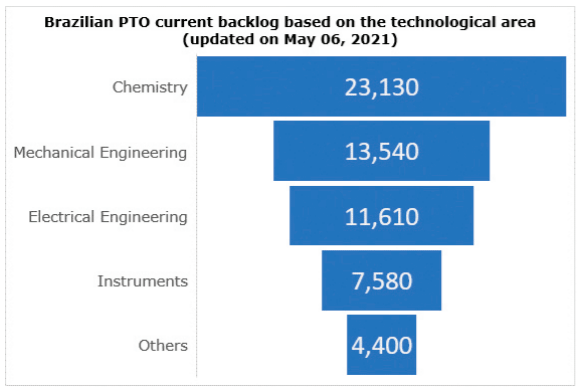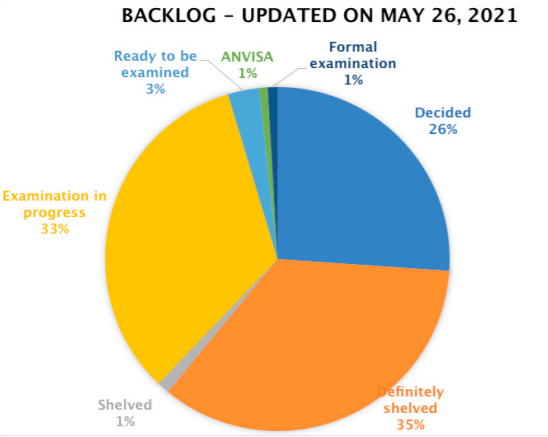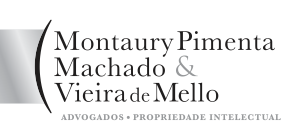Over the past five years, the Brazilian Patent and Trademark Office (BPTO) has adopted various measures to reduce the backlog in patent examinations and implemented several improvements in its examination guidelines to enable high-quality technical examinations to be performed. In addition, the covid-19 pandemic has led to other sensitive discussions regarding the Brazilian patent system and its impact on public health issues. This article provides an overview of six topics that directly affect life sciences patents in Brazil.
Guidelines for Examination of Patent Applications in the Biotechnology Field
The first version of the Guidelines for Examination of Patent Applications in the Biotechnology Field issued by the BPTO was published in 2002 after the IP Law was amended to accept the filing of patent applications claiming chemistry- and biotech-related subject matter. This first document looked more like a draft and was limited in terms of its scope.
It was only in 2015 that the BPTO finally published detailed guidelines to orientate both examiners and applicants as to the rules that should be applied in this specific technological field. However, the biotech industry develops significantly every year, so these guidelines became outdated quite fast.
Therefore, an updated version of the guidelines was issued in 2020 in an attempt to correct the five-year technological gap. Many improvements were made in this regard, such as the inclusion of several examples of ways to draft antibody claims in accordance with local practice. It is important to mention that the definition of "antibodies" in terms of percentage of identity or similarity is still not allowed in Brazil because, according to the guidelines, the characterisation of a sequence of interest based on the identity percentage is broad and generally includes in its scope sequences not supported by the specification or that do not fulfil the patentability requirements. In addition, the guidelines state that, in general, the specification does not provide enough information to allow the reproduction of all of the sequences covered by a definition made in terms of percentage of identity or similarity. However, related progress was made with the acceptance of Markush formulae to define biological sequences, either for nucleotide or amino acid sequences.
The BPTO recognises that it should take less time to update the guidelines to avoid them becoming obsolete and not covering important topics in the biotechnology field. For example, the guidelines do not cover specific rules for the examination of patent applications relating to clustered regularly interspaced short palindromic repeats (CRISPR) technology. Therefore, patent specialists in Brazil hold that the guidelines should be updated at least every year in order to keep up with developments in the biotech field.
Guidelines for Examination of Patent Applications in the Chemistry Field
Unlike the Guidelines for Examination of Patent Applications in the Biotechnology Field, the first (and only) version of the Guidelines for Examination of Patent Applications in the Chemistry Field was published in 2018. The main reason for this apparent delay is that some topics relating to the chemistry field were addressed in the BPTO's general guidelines for examining patent applications belonging to any technological field.
The most relevant aspects of the guidelines specifically drafted for chemistry-related patent applications are:
- an entire chapter that aims to clarify certain aspects of the substantive examination of stereoisomers and different polymorphic forms of a chemical compound;
- the fact that the BPTO has unexpectedly changed its strict position regarding what should be accepted when claiming a composition for medical use; and
- a full chapter detailing the key requirements to obtain protection for a new medical use of a known substance.
More than three years have passed since these guidelines came into effect and the outcome is positive. The BPTO not only clarified the examination of important aspects that had never been discussed before, but also became more flexible in terms of claim language by accepting new ways of drafting claims relating to medical compositions.
Options for fast-track examination
One aspect that has held the attention of the BPTO in recent years is the effort to adopt fast-track examination for various groups of inventions. The BPTO currently has 17 ways to accelerate the examination of patent applications and has made various relevant improvements, particularly in the addition of patent prosecution highway (PPH) agreements and new eligible categories, such as start-ups and small and medium-sized enterprises. Fast-track examination can be requested in Brazil where:
- the applicant is 60 years old or older;
- the applicant has a physically or mentally disabling disease;
- the applicant has a severe illness;
- the applicant is a micro or small company, or an individual microentrepreneur;
- the applicant is a science, technology or innovation institution;
- the applicant is a start-up;
- the application covers a "green" (ie, environmentally friendly) technology;
- the application covers a technology directed to the diagnosis, prophylaxis or treatment of AIDS, cancer or a rare or neglected disease;
- the object of the application is related to a pharmaceutical product, process, equipment or material for use in the diagnosis, prophylaxis or treatment of covid-19;
- the application covers products, processes or equipment considered strategic by public policies of the Ministry of Health (in this case, only the Ministry of Health can request the fast-track examination);
- the application refers to a technology of public interest or national emergency;
- the patent being granted is a condition for the applicant to receive financial aid;
- the object of the application is being reproduced in Brazil without the applicant's consent;
- third parties are being accused of infringement;
- third parties were previously using a technology that was later filed as a patent;
- the application belongs to a patent family whose first application was filed in Brazil; or
- the application was granted in one or more countries that have a PPH agreement with Brazil.
The conditions that relate to diseases and covid-19 are particularly relevant to the life sciences field. However, in principle, all of the aforementioned options can be used to speed up the examination of life sciences-related patent applications, provided that they fulfil one of the requirements. According to statistics provided by the BPTO, almost 5,000 fast-track examination requests have been filed in the past five years. The average time between a fast-track examination request and a final decision on the merits of the invention is about one year, much shorter than the regular timeframe of approximately six years.
Extinction of Anvisa's prior consent for pharmaceutical patent applications
Law 14,195 was passed on 27 August 2021. It eliminates the requirement of prior consent from the Brazilian Health Surveillance Agency (Anvisa) for patent applications relating to pharmaceutical products and processes before the technical examination performed by the BPTO, which was established in article 229-C of the Industrial Property Law.
The measure (article 57, XXVI of the aforementioned law) modified the current rule for patent applications relating to the pharmaceutical field that has been in force in Brazil since 2001. In practical terms, it will allow the pharmaceutical industry to prosecute its patent applications without the need for prior consent from Anvisa, which means that the whole prosecution will take place only within the scope of the BPTO, making the procedure more agile.
Only pharmaceutical patent applications were first sent to a regulatory agency to be approved in Brazil. However, Anvisa's role is to approve the commercialisation of drugs and not to examine patent applications. There is no similar procedure in any other country. Finally, after 20 years, Brazil will no longer have this bureaucratic stage in the examination of patent applications in the pharmaceutical field.
Recent Supreme Court decision on patent term for pharmaceutical products and processes
On 6 May 2021 the Supreme Court decided that the sole paragraph of section 40 of the IP Law is unconstitutional. This legal provision allowed a minimum validity term of 10 years for patents of invention and seven years for utility models, counted from the granting date. After this decision, all patents granted will be valid for 20 years from the filing date, regardless of the time spent by the BPTO in examining the applications. In addition, the decision applies retroactively to already granted patents relating to pharmaceutical products and processes, as well as equipment and materials for use in healthcare. This ex tunc effect of the decision also covers patents that were subject to lawsuits challenging the 10-year rule filed by 7 April 2021, irrespective of the technological field.
Since the Supreme Court decision did not provide any information on how to determine whether a patent relates to the group of cases defined as "pharmaceutical products and processes, medical equipment and materials for use in healthcare", the BPTO is making this classification based on the following criteria:
- patents that were sent to Anvisa for prior consent;
- patents that have the following international patent classification (IPC) numbers: A61B, A61C, A61D, A61F, A61G, A61H, A61J, A61L, A61M, A61N and H05G (these are technologies associated with medicine, according to the World Intellectual Property Office);
- patents that have the following IPC numbers: A61K/6, C12Q/1, G01N/33 and G16H;
- patents about which a lawsuit decision has been published; and
- granted certificates of addition.
The granted patents affected by the retroactive effect are being reissued with the validity term adjusted in the BPTO Official Bulletin. Where the 20-year term counted from the filing date has already elapsed, the extinction of the patent is subsequently published.
BPTO efforts to tackle technical examination backlog
The plan implemented by the BPTO to tackle the patent backlog reduced the amount of pending patent applications by 51.2% in 2020. The final goal is to reduce the number of applications pending a decision by 80%, in addition to reducing the average grant term to approximately two years.
The strategy used by the BPTO to achieve the proposed goal is relatively simple: it will use the results of the analysis of patent applications in other countries and regions (eg, examinations performed by the US Patent and Trademark Office or the European Patent Office).
Currently, the areas most affected by the delay in granting patents in Brazil are chemistry, mechanical engineering and electrical engineering. The chemistry area alone, which includes patent applications in the pharmaceutical and biotechnology fields, is responsible for almost 40% of the current backlog (Figure 1).

Figure 1: current BPTO backlog by technological area
According to the BPTO, approximately 89,000 applications were examined in almost two years, out of 150,000 applications pending examination, thus reducing the backlog by about 60%. Additionally, according to a recent update provided by the BPTO, 33% of the pending patent applications are already under examination (Figure 2). If it keeps this pace, the BPTO will likely be able to solve the backlog issue in a couple of years.
According to the BPTO, approximately 89,000 applications were examined in almost two years, out of 150,000 applications pending examination, thus reducing the backlog by about 60%. Additionally, according to a recent update provided by the BPTO, 33% of the pending patent applications are already under examination (Figure 2). If it keeps this pace, the BPTO will likely be able to solve the backlog issue in a couple of years.

Figure 2: current BPTO backlog by status of applications
Comment
The BPTO is putting a lot of effort into providing a high standard of technical examinations while at the same time making considerable progress in reducing the backlog of patent examinations. These measures have a direct impact on the life sciences field – patent applications in this area can benefit from the new examination guidelines addressing relevant topics specifically relating to biotechnology and chemistry. These developments bring more legal certainty to applicants that seek patent protection in Brazil.
Regarding the Supreme Court decision to abolish the 10-year minimum term of validity for patents of invention, IP specialists are analysing the options to minimise the damages caused to patentees. One of the goals now is to have the financial autonomy of the BPTO implemented by the government. Additionally, there are some remedies that can be used in these cases, such as:
- filing lawsuits to expedite the examination of pending applications; and
- filing a petition before the BPTO if the applicant believes that one or more patents should not be affected by this decision because they do not refer to pharmaceutical products and processes, or to equipment and materials for use in healthcare.
For further information on this topic please contact Gabriela Salerno at Montaury Pimenta, Machado & Vieira de Mello by telephone (+55 21 2524 0510) or email (gabriela.salerno@montaury.
Source:
 Read article here (Life sciences patents in Brazil) | PDF Download
Read article here (Life sciences patents in Brazil) | PDF Download




